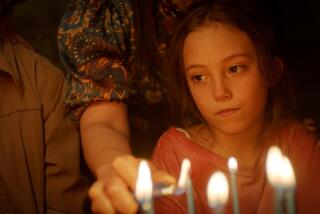Next Stop: Honoring Rod Serling
- Share via
You’re traveling through another dimension, a dimension not only of sight and sound but of mind; a journey into a wondrous land whose boundaries are that of imagination. Next stop: “Rod Serling: The Twilight Zone and Beyond,” a two-month celebration of the award-winning writer’s television work, which kicks off today at the Museum of Television & Radio in Beverly Hills.
Although Serling is best known as the creator and host of the classic 1959-’64 CBS sci-fi anthology series, “The Twilight Zone,” he was also one of the most prolific writers during the era of live television drama of the ‘50s. In fact, beginning in 1955, Serling was awarded three consecutive best teleplay Emmys for “Patterns,” “Requiem for a Heavyweight” and “The Comedian.” All three will be screened as part of the tribute.
Other dramas featured in the festival include the autobiographical 1959 “Playhouse 90: The Velvet Alley,” starring Art Carney; “A Long Time Til Dawn” (1953), a “Kraft Television Theatre,” starring James Dean; and “Knife in the Dark” (1954), directed by his frequent collaborator John Frankenheimer, featuring a young Paul Newman.
Also on display will be “A Town Has Turned to Dust” (1958), a “Playhouse 90” that ran afoul of the censors. Originally an examination about the lynching of African American teenager Emmett Till, the script was changed to be a western allegory about a Latino boy. “By the time the censors had gotten to it, my script had turned to dust,” Serling, who died in 1975, said of the experience.
“I think the one thing that set Rod apart was his sense of irony and macabre,” said William Shat- ner, who appeared in two episodes of “The Twilight Zone”: cult favorite “Nightmare at 20,000 Feet” and “A Town Has Turned to Dust.”
Carol Serling, who was married to the writer from 1948 until his untimely death at age 50, maintains her husband would be shocked by the longevity of his projects. “He would be absolutely amazed, especially with ‘Twilight Zone.’ It’s never been off the air.”
Martin Landau, who starred in two episodes of “Twilight Zone”--including the first one, “Mr. Denton on Doomsday”--recalled a change in Serling when returned to do another installment in 1964. “I think he was getting a little more pressure from people, where he had it easier prior to that.”
Though the festival opens with a weekend marathon of “Twilight Zone” episodes, curator Allen Glover said the tribute’s goal is to shift the focus from the series and follow Serling’s career as a writer.
One of Serling’s most controversial TV movies, “Doomsday Flight,” from 1966, is featured in the festival. The thriller deals with a bomb hidden on a passenger plane that will detonate if the plane dips below 4,000 feet. “Copycat crimes happened almost immediately,” Glover said. “In fact, the first [threat] was phoned in ... while the show was on the air that night. It was taken out of circulation.”
The tribute also will screen four episodes of his 1965 CBS western series “The Loner,” starring Lloyd Bridges, about a Union veteran in search of himself.
A critic of the Vietnam War, Serling was able to express his views in the guise of science fiction on “The Twilight Zone.”
“Rod never felt he was a master of science fiction,” said Carol Serling. “There were so many others who had been writing science fiction for years and still are, but Rod thought it was the right time and a good vehicle. That was the beauty of it. Through anthologies, he could confront these issues, and the sponsor really never understood him. I think that is part of the reason it is still on, because it’s still timely. These issues have never really gone away.”
After his anthology series, “Night Gallery,” was canceled in 1973, Serling taught at Antioch College and lectured on college campuses. Though some documentaries and books have stated that he turned his back on writing for television, Carol Serling said that wasn’t the case but acknowledged that her husband became somewhat discouraged with TV.
“I think the ‘Twilight Zone’ years ... were very heady for him,” she said. “He did have complete creative control, which he did not have on ‘Night Gallery.’ He was a writer and the narrator, but someone else was really in charge, which was also true of the other work that he did after ‘Twilight Zone.’ And he wasn’t an angry young man anymore. He was getting older. But he still cared about television. He was still typing away.”
“Rod Serling: The Twilight Zone and Beyond” begins today and continues through April 21 at the Museum of Television & Radio, 465 N. Beverly Drive, Beverly Hills. Screenings are Wednesdays to Sundays at 3 p.m. and Thursdays at 7 p.m. The Twilight Zone Marathon Weekend, today through Sunday, will screen from 12:15 to 5 p.m. each day. Admission is free. Information: (310) 786-1000 or www.mtr.org.
More to Read
The biggest entertainment stories
Get our big stories about Hollywood, film, television, music, arts, culture and more right in your inbox as soon as they publish.
You may occasionally receive promotional content from the Los Angeles Times.











